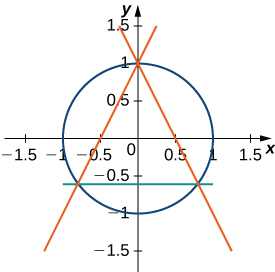4.E: Basic Concepts of Euclidean Geometry (Exercises)
( \newcommand{\kernel}{\mathrm{null}\,}\)
Exercise 4.E.1: Similarity
Assess whether each of the following statement is true or false and justify your answer.
- Any two equilateral triangles are similar.
- Any two isosceles triangles are similar.
- Any two squares are similar.
- Any two rectangles are similar.
- Any two pentagons are similar.
- Any two polygons are similar.
Exercise 4.E.2: Area
Starting with the formula for the area of a triangle, show how to obtain the formula for the area of a parallelogram and the area of a hexagon.
Exercise 4.E.3: Interior angle
Find the general formula for the center angle in a regular n-sided polygon. Justify your answer.
Find the general formula for the exterior angle in a regular n-sided polygon. Justify your answer.
Exercise 4.E.4: Triangles
Prove or disprove the following: an equilateral triangle is an isosceles triangle.
Explain why an equilateral triangle is not a scalene triangle.
Exercise 4.E.5: True or False
Explain why the following statements below are true.
- A square is a rectangle.
- A rectangle is a parallelogram.
- A square is a kite.
- A parallelogram is a trapezoid.
Exercise 4.E.6: Angles
Given cutout sheets with angles 40∘,55∘ and 85∘. By adding or subtracting angles, construct other angles that measure 15∘,30∘,70∘,95∘and 100∘.
Can you construct an angle that measures 75∘?Explain how or say why not.
Exercise 4.E.7: Converse of the Pythagorean Theorem
State the statement for the converse of the Pythagorean Theorem. Is this statement true or false? Justify your answer.
Exercise 4.E.8: Venn diagram
Create a Venn diagram to illustrate the types of quadrilaterals listed in this section.
Exercise 4.E.9: Parallelogram
Let (a;b);((0;c);(d:e);(f;0) be vertices of a quadrilateral. Show that if you take the midpoints of any quadrilateral and connect them in turn, you will always get a parallelogram.
Exercise 4.E.10: Venn Triangles
Express the relationship between scalene, isosceles and equilateral triangles with a Venn diagram.
Exercise 4.E.11: Angles
Consider the figure:
Given that \( a= 47^{\circ}, \) and \(c= 55^{\circ}.\)
Find other listed angles.
Exercise 4.E.12:
Refer to the cube picture above.
Name the following:
- Two line segments that do not lie in the same plane.
- Two intersecting line segments.
- Three concurrent line segments that do not lie in the same plane.
- Two skew line segments.
- A pair of supplementary angles.
- A pair of perpendicular line segments.
- Two parallel line segments.
Exercise 4.E.13: Inner Circle
Find the area between the perimeter of this square and the unit circle.

- Answer
-
1−π
Exercise 4.E.14: Outer Circle
Find the area between the perimeter of the unit circle and the triangle created from connecting the points (0,1),(−45,−35)and (45,−35), as seen in the following figure.

- Answer
-
(\displaystyle π−\frac{32}{25}\)
Exercise 4.E.15: Reuleaux triangle
The Reuleaux triangle consists of an equilateral triangle and three regions, each of them bounded by the side of the triangle and an arc of a circle of radius \(s \) centred at the opposite vertex of the triangle. Show that the area of the Reuleaux triangle in the following figure of side length s is s22(π−√3).

https://texample.net/tikz/examples/all/
Exercises 13-16 are from
Gilbert Strang (MIT) and Edwin “Jed” Herman (Harvey Mudd) with many contributing authors. This content by OpenStax is licensed with a CC-BY-SA-NC 4.0 license. Download for free at http://cnx.org.


